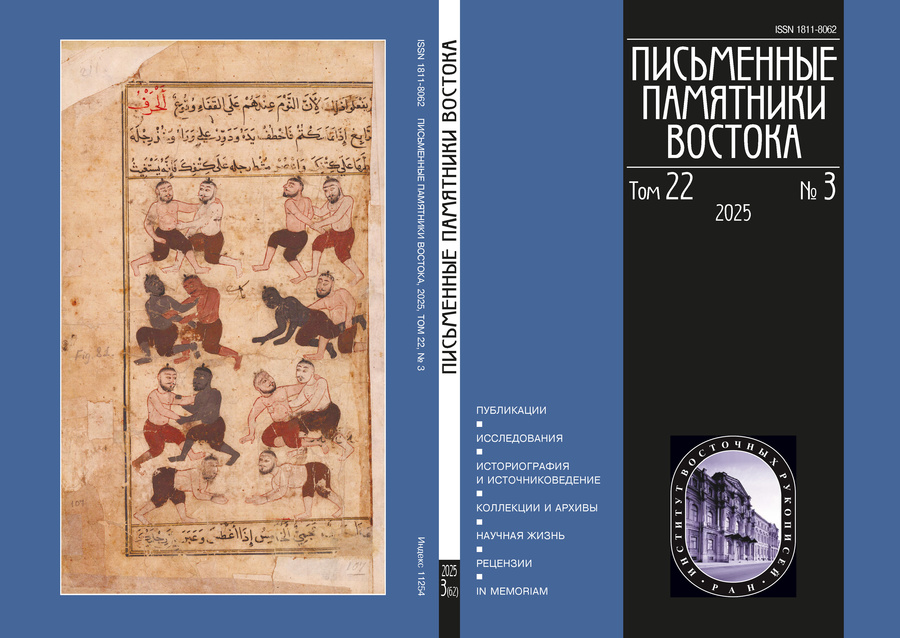Традиционный японский меч нихонто: как носитель надписей и текстов
- Авторы: Синицын А.Ю.1, Габитова А.И.2
-
Учреждения:
- Музей антропологии и этнографии им. Петра Великого (Кунсткамера) РАН
- Институт восточных рукописей РАН
- Выпуск: Том 22, № 3 (2025)
- Страницы: 42-58
- Раздел: Исследования
- Статья опубликована: 30.09.2025
- URL: https://journals.eco-vector.com/1811-8062/article/view/683409
- DOI: https://doi.org/10.55512/WMO683409
- ID: 683409
Цитировать
Полный текст
Аннотация
В парадигме традиционной японской культуры меч нихонто: 日本刀 выступает не только как холодное оружие и произведение декоративно-прикладного искусства, но и как объект почитания в синтоистских и буддийских культах, как носитель сакральных смыслов и символов, а также разнообразных надписей и текстов. Статья посвящена анализу и систематизации типичных надписей на традиционных японских мечах (в основном на черенах клинков), структуре и характеру заключенной в них информации. За всю историю нихонто: сложилась особая культура составления подобных надписей, которые могли быть как крайне лаконичными, так и весьма развернутыми. Некоторые развернутые надписи можно рассматривать как своеобразный литературный нарратив, включающий игру смыслов и даже поэтический компонент.
Ключевые слова
Об авторах
Александр Юрьевич Синицын
Музей антропологии и этнографии им. Петра Великого (Кунсткамера) РАН
Email: asin@kunstkamera.ru
ORCID iD: 0000-0001-7392-1837
кандидат исторических наук, старший научный сотрудник, Отдел Восточной и Юго-Восточной Азии
Россия, Санкт-ПетербургАрина Ильшатовна Габитова
Институт восточных рукописей РАН
Автор, ответственный за переписку.
Email: arina.gabitova@mail.ru
ORCID iD: 0009-0008-4838-9824
старший лаборант, Отдел Дальнего Востока
Россия, Санкт-ПетербургСписок литературы
- Баженов 2003 — Баженов А.Г. Экспертиза японского меча. СПб.: Атлант, 2003.
- Габитова 2022 — Габитова А.И. Система дзиккан-дзюниси как основа традиционного японского календаря // Япония: цивилизация, культура, язык 2022. «Issues оf Japanology = Вопросы японоведения» № 9. СПб.: Изд-во Art-xpress, 2022. С. 14–21.
- Гассан 2010 — Японские кузнецы мечей: Традиция Гассан / Под ред. А.В. Щекотова. Жигулевск: Стрелец, 2010.
- Сеско 2023 — Сеско М. Тамэсигири: история и развитие испытаний японского меча. М.: «Издательство у Никитских ворот», 2023.
- Синицын 2021 — Синицын А.Ю. Японские мечи в собрании Музея антропологии и этнографии имени Петра Великого (Кунсткамера) РАН // Оружейный сборник. Вып. I. Материалы заседаний Оружейного семинара Государственного Эрмитажа, 2016–2020. Памяти Л.И. Тарасюка. СПб.: Изд-во Гос. Эрмитажа, 2021. С. 328–339.
- Успенский 2004 — Успенский М.В. Меч Кавадзи Тосиакира // Из истории японского искусства. Сб. ст. СПб.: Изд-во Гос. Эрмитажа, 2004. С. 131–135.
- Фудзисиро 1937 — Фудзисиро Ёсио 藤代義雄. Нихон то:ко: дзитэн. Синто:хэн. 日本刀工辞典 新刀篇 (Словарь японских мастеров меча. Том синто:). Токио: Фудзирио сётэн, 1937.
- Фуллер, Грегори 2002 — Фуллер Р., Грегори Р. Японское военное и гражданское холодное оружие. М.: Аст-Астрель, 2002.
- Art of the Samurai 2009 — Art of the Samurai: Japanese Arms and Armor, 1156–1868. / Ed. by Ogawa, Morihiro, Harada Kazutoshi, Ikeda Hiroshi et al. New York: The MET Publications, 2009.
- Kanzan 1983 — Kanzan Sato. The Japanese Sword. A Comprehensive Guide. Tokyo; New York; London: Kodansha International, 1983.
- Kapp, Yoshihara 2003 — Kapp L., Yoshihara Yoshindo. Modern Japanese Swords and Swordsmiths: From 1868 to the Present. Tokyo; New York: Kodansha International, 2003.
- Sesko 2014 — Sesko M. Encyclopedia of Japanese Sword. Norderstedt: Lulu Enterprises, 2014.
- Сирахаги 2020 — Сирахаги интэцу то рю:сэйто:. 白萩隕鉄と流星刀 [Метеорит Сирахаги и клинок из метеорита] // Тояма си кагаку хакубуцукан 富山市科学博物館 [Музей науки города Тояма]. URL: https://www.tsm.toyama.toyama.jp/?tid=101911 (дата обращения: 05.03.2025).
- Minatogawa 2020 — Newly Found Minatogawa Jinja katana // Nihonto Message Board, September 1, 2020. URL: https://www.militaria.co.za/nmb/topic/33117-newly-found-minatogawa-jinja-katana/ (дата обращения: 27.01.2025).
- Nagasone 2015 — Nagasone Kotetsu. Sho-shin. Smiths-Koto-Shinto: https://www.sho-shin.com/edo-nagasone.html (дата обращения: 01.03.2025).
- Sesko 2013 — Sesko M. About the Correct Translation of Certain Sword Signatures // Markus Sesko. Japanese Arms and Armor. URL: https://markussesko.com/2013/02/17/about-the-correct-translation-of-certain-sword-signatures/ (дата обращения: 17.02.2025).
Дополнительные файлы












